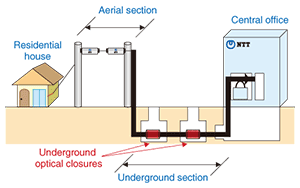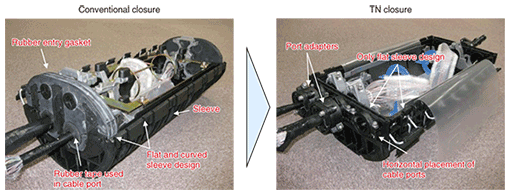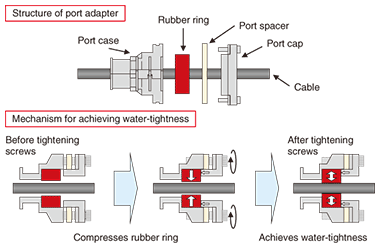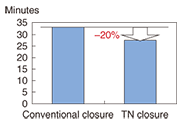 |
|||||
|
|
|||||
|
Letters Vol. 8, No. 3, pp. 31–34, Mar. 2010. https://doi.org/10.53829/ntr201003le2 Development of Underground Optical Closure with Improved Assembly and Water-tightnessAbstractA new underground optical closure provides easier assembly and better water-tightness for cable connections. It will reduce both the operating and construction costs for fiber-to-the-home (FTTH) service.
1. IntroductionThe number of fiber-to-the-home (FTTH) subscribers in Japan is increasing rapidly and reached 15.8 million in June 2009, corresponding to a market share of 51.4% [1]. The rising demand for FTTH service will require the installation of more and more underground optical fiber cables. To enable optical fibers to be utilized and operated effectively, we have developed a new underground optical closure to make assembly easier and to achieve water-tightness for cable connections. 2. ConceptFTTH service is generally supplied from an NTT building to a customer’s home via underground and aerial access lines (Fig. 1). In an underground section, new optical fibers are connected in response to an increase in the number of FTTH customers. Therefore, closures must be opened and shut frequently, which makes it difficult to maintain water-tightness. Furthermore, skill is needed to achieve the required degree of water-tightness when assembling existing underground optical closures. This has caused a considerable variation in the quality of assembly work, and the rate of closures penetrated by water has increased. To tackle these issues, we have developed the Triple N (TN) closure, where the three Ns stand for no gas, no water, and no sealing tape. The concepts behind the TN closure are as follows:
3. DevelopmentThe conventional closure and the TN closure are shown in Fig. 2. The TN closure incorporates three improvements designed to achieve easy assembly and good water-tightness (Fig. 3).
3.1 Flat sleeve designSince the conventional closure has portions where the contact surface of the sleeve is not flat, the pressure is not constant when the closure is shut, so sealing tape is used to achieve water-tightness. To achieve a constant pressure on the contact surface when the closure is shut, we changed the sleeve design from flat and curved to solely flat. The flat sleeve design makes sealing tape unnecessary and makes the closure easier to open and shut. As a result, better water-tightness is achieved. Moreover, the use of larger fasteners makes the task of opening and shutting the closure easier. The TN closure has a structure composed of three sleeves. The use of common sleeves helps to reduce the number of different components. 3.2 Horizontal placement of cable portsWith the conventional rubber entry gasket, a worker must take care during work involving the cable ports to avoid affecting existing cables when installing a new cable. The TN closure has horizontal cable ports, which make it possible for a worker to work on the cable ports independently and from above. As a result, it is easy to install a new cable. 3.3 Port adapterIn the conventional closure, water-tightness at a cable port is achieved by using a rubber entry gasket and rubber tape. However, the tape must be cut to suit the outside diameter of the cable and wrapped by hand. This has led to a large difference in the quality of assembly work, and skill is required to maintain good water-tightness. In the new closure, a port adapter replaces the rubber wrapping tape to achieve water-tightness at a cable port. As shown in Fig. 4, it consists of a port case, a rubber ring, a port spacer, and a port cap. The port cap, which is attached with screws, compresses the rubber ring, which fills the space around the cable. The port spacer adjusts the pressure exerted on the rubber ring. If an appropriate rubber ring and port spacer are selected to suit the cable diameter, then the port adapter is applicable to cables with an outside diameter of 8–33 mm. The rubber ring and port spacer sizes can be estimated by wrapping a scale around the cable. Since a worker assembles the rubber ring, port spacer, and port cap in the port case using screws rather than by manually cutting and wrapping a rubber tape, water-tightness can be achieved regardless of the worker’s skill.
3.4 EffectAs a result of these improvements, the TN closure provides two major advantages.
By changing the entry gasket structure and sleeve design, we eliminated the need for the sealing tape previously used for achieving water-tightness. This reduces the time needed for cleaning the sleeves and allows easy assembly. As a result of these improvements, the assembly time with the TN closure is 20% shorter than that with the conventional closure (Fig. 5).
4. ConclusionWe have developed a new underground optical closure that is easier to assemble and has improved water-tightness, which will allow us to reduce both construction and maintenance costs for FTTH service in the future. It was put to practical use by NTT EAST and NTT WEST in June 2009. Reference
|
|||||

















